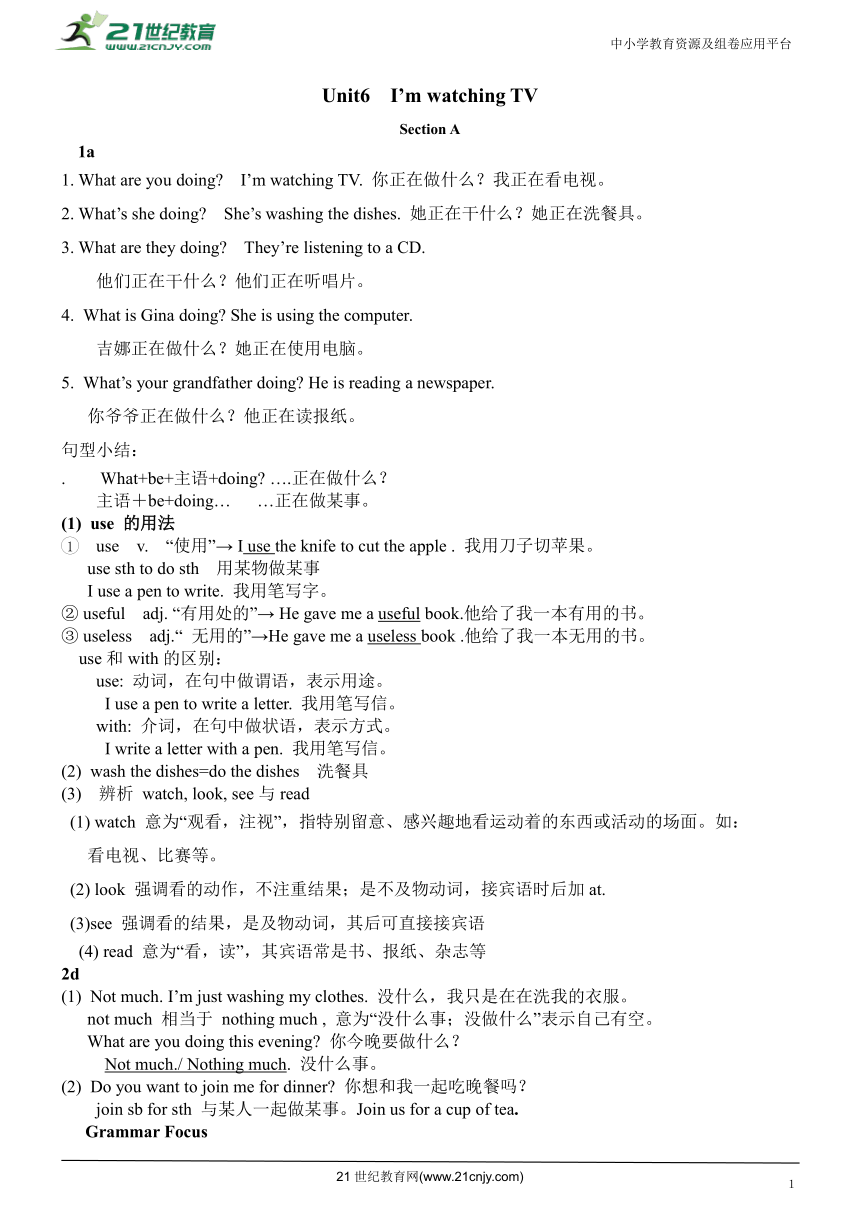
中小学教育资源及组卷应用平台 Unit6 I’m watching TV Section A 1a 1. What are you doing I’m watching TV. 你正在做什么?我正在看电视。 2. What’s she doing She’s washing the dishes. 她正在干什么?她正在洗餐具。 3. What are they doing They’re listening to a CD. 他们正在干什么?他们正在听唱片。 What is Gina doing She is using the computer. 吉娜正在做什么?她正在使用电脑。 What’s your grandfather doing He is reading a newspaper. 你爷爷正在做什么?他正在读报纸。 句型小结: . What+be+主语+doing ….正在做什么? 主语+be+doing… …正在做某事。 use 的用法 use v. “使用”→ I use the knife to cut the apple . 我用刀子切苹果。 use sth to do sth 用某物做某事 I use a pen to write. 我用笔写字。 ② useful adj. “有用处的”→ He gave me a useful book.他给了我一本有用的书。 ③ useless adj.“ 无用的”→He gave me a useless book .他给了我一本无用的书。 use和with的区别: use: 动词,在句中做谓语,表示用途。 I use a pen to write a letter. 我用笔写信。 with: 介词,在句中做状语,表示方式。 I write a letter with a pen. 我用笔写信。 wash the dishes=do the dishes 洗餐具 辨析 watch, look, see与read (1) watch 意为“观看,注视”,指特别留意、感兴趣地看运动着的东西或活动的场面。如: 看电视、比赛等。 (2) look 强调看的动作,不注重结果;是不及物动词,接宾语时后加at. (3)see 强调看的结果,是及物动词,其后可直接接宾语 (4) read 意为“看,读”,其宾语常是书、报纸、杂志等 2d Not much. I’m just washing my clothes. 没什么,我只是在在洗我的衣服。 not much 相当于 nothing much , 意为“没什么事;没做什么”表示自己有空。 What are you doing this evening 你今晚要做什么? Not much./ Nothing much. 没什么事。 Do you want to join me for dinner 你想和我一起吃晚餐吗? join sb for sth 与某人一起做某事。Join us for a cup of tea. Grammar Focus Are you doing your homework Yes, I am./ No, I’m not. I’m cleaning my room. 你正在做家庭作业吗?/ 是的。/ 不,我正在打扫我的房间。 Is he reading a newspaper Yes, he is,/ No, he isn’t. He’s playing basketball. 他在看报吗?是的。/ 不,他正在打篮球。 Are they using the computer Yes, they are./ No, they aren’t. They’re exercising. 他们正在用电脑吗?是的。/不,他们在锻炼。 . 现在进行时(The Present Progressive Tense) 1) 现在进行时表示现在(说话瞬间)正在进行或发生的的动作。如: The student are listening to the teacher. He is watching TV now. 现在进行时也可表示当前一段时间内的活动或现阶段正在进行的动作。 We are working on a farm these days. I’m writing a book this month. 2) 构成:be(am/is/are) + v-ing。以动词work为例,现在进行时的肯定式、否定式、疑问式和简略答语如下: ①肯定式 I am working. You are working. He / She / It is working. We / You / They are working. ②否定式 I am not working. You are not working. He / She / It is not working. We / You / They are not working. ③疑问式和简略答语: Am I working Are you working Yes, you are. Yes, I am. No, you are not (aren’t) No, I am not. Is he / she / it working Are we working Yes, he / she / it is. Yes, you are. No, he / she / it is not (isn’t). No, you are not (aren’t) Are you working Are they working Yes, we a ... ...
~~ 您好,已阅读到文档的结尾了 ~~